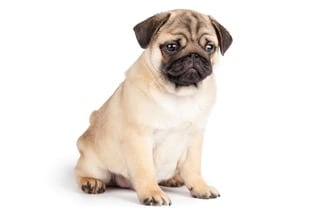
The Pug is an ancient breed originated in China as a companion dog, they were favorite pets of the Chinese imperial rulers. The first known mention of a Pug was in a book written between 600 and 900 BC. Pugs are perfect companion dogs, very loving, easy to please and very smart; they are well known for their mischievous and clownish personality. Pugs are a medium sized breed with a sturdy and square body, a defined wrinkle on their head and short muzzle, along with their small rose-like ears, big and sparkly round eyes, double coats and curly tail, and they come in a wide variety of colors such as fawn, apricot, black, and silver. It is believed that the Pug descend from a mix of different dog breeds such as the Pekingese, Mastiff, Bulldogs, and French Bulldogs. The main thing that makes the Pug stand out from other dog breeds is their unique facial wrinkles and their loyal and devotion personalities.
Pugs are affectionate, friendly, and gentle companions. They are highly intelligent and love to play, showing great exercise and activity needs. They are also patient and tolerant, although early socialization and training will help them adjust to situations better. They get along great with children and other pets, as they are very tolerant and friendly. They are quite high-energy and require regular exercise, such as daily walks, runs, or playtime. They are suitable for apartment living and can be kept indoors, although their snoring and snorting can be a bit noisy at times! Pugs love to bond with their owners and thrive on quality time spent together. With proper exercise, training, and love, Pugs make incredible companions!
The Pug is a popular dog breed known for its docile and friendly nature. They can sprint fast, so they’re relatively active dogs that require healthy nutrition. To ensure your Pug remains in good health, feed him a balanced, nutritious diet that’s rich in proteins, carbohydrates, fats, vitamins and minerals. Avoid low quality foods that have preservatives or fillers. Splitting meals into two or three portions per day is recommended. You should also make sure your Pug maintains its ideal weight and adjust feeding amounts accordingly, and ensure he gets enough exercise.
Responsible ownership and adoption are also important when caring for a Pug. A proper diet and regular exercise keep them happy and healthy, and can even help prevent certain common issues such as skin irritation and joint problems.
For an even more personalized approach to your Pug’s diet, consider visiting Way Canina. They offer personalized nutrition advice and tailored recipes for pugs, so you can be sure your pup is getting the best nutrition.
To recap, the Pug’s nutritional requirements include a balanced, nutritious diet that’s rich in proteins, carbohydrates, fats, vitamins and minerals. Avoid low quality foods with fillers and preservatives, and consider visiting Way Canina for personalized nutrition advice and recipes tailored to your Pug. With the proper nutrition and exercise, you can ensure your Pug remains happy and healthy for many years to come!
The pug is a small, fun-loving breed of dog that originated in China. Common health issues associated with pugs can include hip dysplasia, eye and nasal issues, heat stroke, and breathing problems. Unfortunately, pugs can also be predisposed to certain genetic conditions so it is very important to have regular veterinary check-ups to detect and prevent any potential issues. Vaccinations and preventive care, like flea and tick treatments, are also important for a pug’s overall well-being. Grooming a pug involves brushing fur daily, bathing and drying once a month, and cleaning ears when needed. Due to their short muzzles, pugs require a diet high in protein and low in carbohydrates in order to assist in their digestion. Portion control and regular exercise are also important in order to prevent obesity in this breed.
On average, pugs live to be 12-15 years of age and factors such as genetics, diet, exercise, and access to healthcare can all affect the lifespan of a pug.
Do you own a Pug or are you considering getting one? Owning a pet is a serious responsibility, so make sure you weigh the pros and cons of ownership before taking the plunge! For more information on Pugs, as well as other breeds, take a look at Way Canina’s blog posts and articles on dog lifestyle and wellbeing.